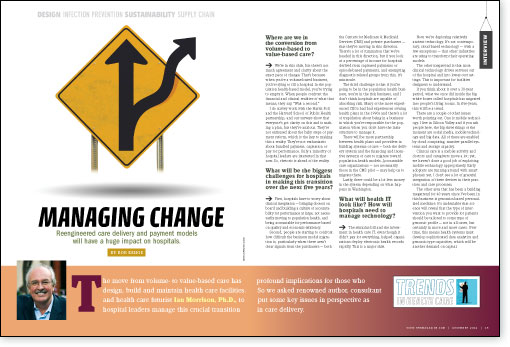
The move from volume- to value-based care has profound implications for those who design, build and maintain health care facilities. So we asked renowned author, consultant and health care futurist Ian Morrison, Ph.D., to put some key issues in perspective as hospital leaders manage this crucial transition in care delivery.
Where are we in the conversion from volume-based to value-based care?
We're in this shift, but there's not much agreement and clarity about the exact pace of change. That's because when you're a volume-based business, you're trying to fill a hospital; in the population health-based model, you're trying to empty it. When people confront the financial and clinical realities of what that means, they say, "Wait a second."
I do survey work with the Harris Poll and the Harvard School of Public Health partnership, and our surveys show that everyone's got clarity on this and is making a plan, but they're anxious. They're not enthused about the baby steps of payment reform, which is the key to making this a reality. They're not enthusiastic about bundled payment, capitation or pay for performance. Only a minority of hospital leaders are interested in that now. So, rhetoric is ahead of the reality.
What will be the biggest challenges for hospitals in making this transition over the next five years?
First, hospitals have to worry about clinical integration — bringing doctors on board and building a culture of accountability for performance at large, not necessarily moving to population health, and being accountable for performance based on quality and economic efficiency.
Second, people are starting to confront how difficult the business model migration is, particularly when there aren't clear signals from the purchasers — both the Centers for Medicare & Medicaid Services (CMS) and private purchasers — that they're moving in this direction. There's a lot of rumination that we're headed in this direction, but if you look at a percentage of income for hospitals derived from capitated payments or episode-based payments, and exempting diagnostic-related groups from this, it's miniscule.
The third challenge is that if you're going to be in the population health business, you're in the risk business, and I don't think hospitals are capable of absorbing risk. Many of the more experienced CEOs had bad experiences owning health plans in the 1990s and there's a lot of trepidation about being in a business in which you're responsible for the popÂulation when you don't have the infrastructure to manage it.
There will be more partnership between health plans and providers in building systems of care — both the delivery system and the financing and incentive systems of care to migrate toward population-health models. Accountable care organizations — not necessarily those in the CMS pilot — may help us to migrate there.
Lastly, there could be a lot less money in the system depending on what happens in Washington.
What will health IT look like? How will hospitals need to manage technology?
The stimulus bill and the investment in health care IT, even though it didn't pay for everything, helped organizations deploy electronic health records rapidly. This is a major shift.
Now, we're deploying relatively ancient technology. It's not contemporary, cloud-based technology — with a few exceptions — that other industries are using to transform their operating models.
The other megatrend is that most clinical technology drives services out of the hospital and into lower-cost settings. This is important for facilities designers to understand.
If you think about it over a 20-year period, what we once did inside the big white boxes called hospitals has migrated into people's living rooms. In five-years, this will be a trend.
There are a couple of other issues worth pointing out. One is mobile technology. I live in Silicon Valley and if you ask people here, the big three things of the moment are social media, mobile technology and big data. All of these are enabled by cloud computing, massive parallel systems and storage capacity.
Clinical care is a mobile activity and doctors and caregivers move a lot; yet, we haven't done a good job of exploiting mobile technology appropriately. Early adopters are running around with smart phones; yet, I don't see a lot of graceful integration of these devices in their practices and care processes.
The other area that has been a building megatrend for 40 years since I've been in this business is genomics-based personalized medicine. It's undeniable that science will reveal that the type of intervention you want to provide for patients should be tailored to some type of genomic profile — not in all cases, but certainly in more and more cases. Over time, this means health systems must develop sophisticated data analytics and genomic-type capacities, which will be another demand on capital.
Where is population health today and how will it evolve?
It's a massive shift and we're not far along on that journey.
We asked about this in a study we conducted with KPMG. We developed four word-picture scenarios and two stood out. One is what we called steady integration, where within five years, 25 percent or less of the funding for health care systems would come through population health-oriented income streams. The other scenario that stood out is where the integration is more rapid, where the majority of people are on that model. We found that people desired more rapid integration — in other words, clear signals that we're moving in that direction. The plurality — not the majority — felt we'd be stuck between these two paradigms within five years. That's consistent with what I see.
How will this shifting environment impact demand for hospital services?
This is where facilities planners have a tough challenge. You've got to factor in some of the variables we've talked about. What's the likely impact of moving toward the population-health model?
Here's an example. California is a highly managed care state with a high penetration of Medicare Advantage patients. Leaders of medical groups who are in the capitation business are eager to take on more Medicare fee-for-service patients, because they know that if they bring them into their payment model and their care system, they can reduce the bed days per thousand for Medicare recipients from 1,600 in the fee-for-service population to 900 if they manage it. That's a massive reduction in utilization of hospitals. They manage the patients better and they drive people into lower-cost settings.
The demand for services is conditioned by a number of factors, not the least of which is how you manage patients through this process. There are a number of trends going in both directions. There will be a couple of areas in which we will see increasing demand for services. One is aging and the other is obesity, which involves medicalization. There is a huge growth in health care expenditures because people are living longer and we are finding new ways to treat their illnesses.
The other countervailing forces are care being managed more tightly by at-risk medical groups, which is good, and rising out-of-pocket costs. Medicaid is becoming much more restrictive and ruminating about cost-sharing even though beneficiaries are able to pay relatively little. What we know is that when people have to pay out of pocket, they use services less.
So, at the aggregate level of facility demand, you have forces driving increased utilization and forces potentially reducing utilization. Right now, the latter forces are winning and we're seeing a slowing rate of growth in utilization across the board, particularly in areas where people have time to reconsider choices and forgo care for such procedures as knee and hip replacement.
The facilities planner has a tough job navigating through this and adjusting it through the local demographics. And all hospital systems are now aggressively building and expanding facilities — largely as a defensive measure to capture and shore up market territory. We'll soon find out whether that's a smart strategy.
Are existing hospitals suitable for this new care delivery environment?
One of the interesting questions is: What does the built environment for this new system look like? I haven't seen anyone who has real clarity around
that issue.
You could argue: Look at Kaiser. They have substantial ambulatory care facilities and, in some markets like Washington, they build hubs. They contract for hospitals on the spot market and only build when they can be guaranteed to fill them. When Kaiser does build, it uses a cookie-cutter, standardized, well-researched, industrial-engineered box that delivers acute care. Some see this as the built enÂvironment needed for a true accountable care organization/population-health model, since Kaiser is an end-to-end system.
Kaiser has figured out how to get all the money and control all the processes that impact production. It's certainly not the only way.
And you're starting to see people re-thinking regional health systems, particularly rural hospitals.
I've been urging the rural communities to repurpose rather than close rural hospitals. These facilities can become community service centers that have great transportation links, lots of telemedicine, high-tech diagnostics, and maybe some chronic care infrastructure and long-term care step-down units. What they shouldn't be doing is elective surgery of poor quality at low volume.
It's a big challenge for the design and facilities field to operationalize what the built environment for the population-health model should look like. It's a big question and I'm not convinced I've seen good examples of it. What I see is a lot of defensive shoring up, constructing fancy buildings with atriums to attract a disproportionate share of the private-pay crowd.
Bob Kehoe is associate publisher of Health Facilities Management.





